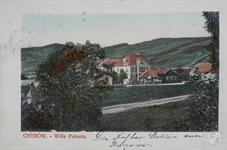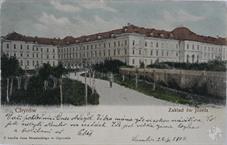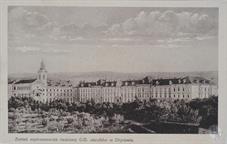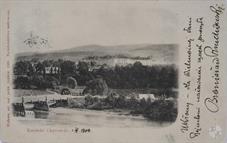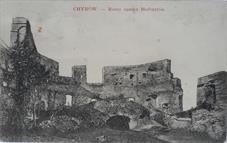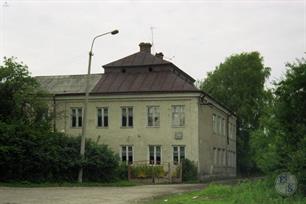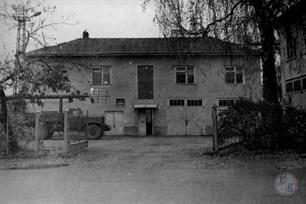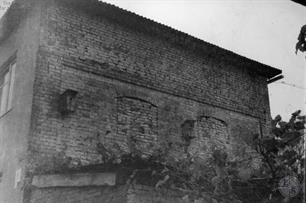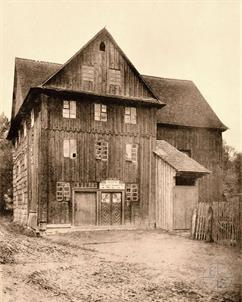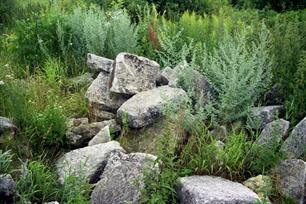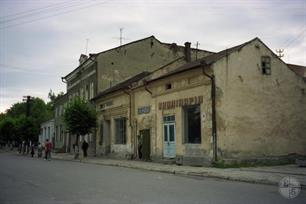Khyriv
Sambir district, Lviv region
Sources:
- Pinkas Hakehillot Polin: Encyclopedia of Jewish Communities, Poland, Volume II, published by Yad Vashem, Jerusalem.
Photo:
- European Jewish Cemeteries Initiative. Khyriv Old Jewish Сemetery
- Benjamin Lukin, Center for Jewish art. Khyriv (Chyrow, Khyrov)
- Biblioteka Narodowa Polona. Chyrow
- Titus D. Hewryk Masterpieces in wood: houses of worship in Ukraine
- Pinkas Hakehillot Polin: Encyclopedia of Jewish Communities, Poland, Volume II, published by Yad Vashem, Jerusalem.
Photo:
- European Jewish Cemeteries Initiative. Khyriv Old Jewish Сemetery
- Benjamin Lukin, Center for Jewish art. Khyriv (Chyrow, Khyrov)
- Biblioteka Narodowa Polona. Chyrow
- Titus D. Hewryk Masterpieces in wood: houses of worship in Ukraine
Until the First World War, most of the Jewish children studied in heders, and a few in a general school in the town, which was under the influence of the Jesuits.
In 1910 an anti-Semitic incident broke out in which Polish nationalist students visiting Khyriv smashed windows in Jewish homes and attacked several Jews in the street.
In the post-war period, the Jewish population reduced to 919 (34,6% of the total population) by 1921.
In 1922, a complementary Hebrew school was established, where 25 girls studied.
Next to the school was a cultural association called "Tarbut" which had a library.
A relationship of mutual aid were existed between the Jews of Khyriv and the Jews of Pshemyshl and Sambir. In 1928, the Jews of Khyriv donated to the Jewish Hospital in Pshemyshl.
In 1910 an anti-Semitic incident broke out in which Polish nationalist students visiting Khyriv smashed windows in Jewish homes and attacked several Jews in the street.
In the post-war period, the Jewish population reduced to 919 (34,6% of the total population) by 1921.
In 1922, a complementary Hebrew school was established, where 25 girls studied.
Next to the school was a cultural association called "Tarbut" which had a library.
A relationship of mutual aid were existed between the Jews of Khyriv and the Jews of Pshemyshl and Sambir. In 1928, the Jews of Khyriv donated to the Jewish Hospital in Pshemyshl.
Khyriv (ukr. Хирів) was first mentioned in documents from 1374. At that time it was the private property of the noble Polish family of Herburt and was part of Poland's Ruthenian Voivodeship. In 1528 Chyr?w, as it is called in Polish, received Magdeburg rights.
In 1941, 2,654 residents lived in Khyriv, of which 919 were Jews.
In the Holocaust of European Jews, the Jewish settlement in Hirov was eliminated in July 1942 when the Germans destroyed most of the Jewish settlements in the Pshemychl region. Apparently the Jews of Khyriv were moved to nearby Dobromil.
An extermination action took place there on July 29, 1942, and the Jews of the town and other Jews found there were sent to be exterminated in the Belzec camp.
In the Holocaust of European Jews, the Jewish settlement in Hirov was eliminated in July 1942 when the Germans destroyed most of the Jewish settlements in the Pshemychl region. Apparently the Jews of Khyriv were moved to nearby Dobromil.
An extermination action took place there on July 29, 1942, and the Jews of the town and other Jews found there were sent to be exterminated in the Belzec camp.
It is possible that Jews contributed to the establishment of the city. The first information about the Jews of Khyriv comes from 1544.
Over the years they were engaged in trade, and some of them in crafts.
In 1740 the first synagogue was built, and in the 19th century a second synagogue was established.
In 1927, a charity pharmacy was established.
Over time, most of the Jews joined Hasidicism.
The Admorim (Rebbes) from family of Rabbi Naftali Zvi Horowitz of Ropshitz standed out by their influence.
From the middle of the 19th century until the Holocaust, the rabbis in Khyriv were representatives of the Rimlet family.
Over the years they were engaged in trade, and some of them in crafts.
In 1740 the first synagogue was built, and in the 19th century a second synagogue was established.
In 1927, a charity pharmacy was established.
Over time, most of the Jews joined Hasidicism.
The Admorim (Rebbes) from family of Rabbi Naftali Zvi Horowitz of Ropshitz standed out by their influence.
From the middle of the 19th century until the Holocaust, the rabbis in Khyriv were representatives of the Rimlet family.
In 1859, 574 Jews (30,7% of the total population) lived in Khyriv.
The peak of the Jewish population was 1,164 (39,8% of the total population) in 1900.
In the early 20th century, the Zionist movement became active. Zionist's union “Tkhiya” (“Revival”) and women association “Debora” were established.
In 1903, a "Blood slander" broke out in the settlement when a Christian maid who went to see the rabbi complained that the Jews were sucking blood from her. The authorities worked to calm the emotions.
Between the two world wars, the political arena in the Jewish community was dominated by the General Zionists. Their youth movement, the Zionist Youth, had 70 members in 1936.
In the city council, on the other hand, Jews entered only on behalf of the ruling list of Marshal Yozef Pilsudski.
The peak of the Jewish population was 1,164 (39,8% of the total population) in 1900.
In the early 20th century, the Zionist movement became active. Zionist's union “Tkhiya” (“Revival”) and women association “Debora” were established.
In 1903, a "Blood slander" broke out in the settlement when a Christian maid who went to see the rabbi complained that the Jews were sucking blood from her. The authorities worked to calm the emotions.
Between the two world wars, the political arena in the Jewish community was dominated by the General Zionists. Their youth movement, the Zionist Youth, had 70 members in 1936.
In the city council, on the other hand, Jews entered only on behalf of the ruling list of Marshal Yozef Pilsudski.

- Home
- Shtetls
- Vinnytsia region
- Volyn region
- Dnipro region
- Donetsk region
- Zhytomyr region
- Zakarpattia region
- Zaporizhzhia region
- Ivano-Frankivsk region
- Kyiv region
- Kropyvnytskyi region
- Luhansk region
- Lviv region
- Mykolayiv region
- Odessa region
- Poltava region
- Rivne region
- Sumy region
- Ternopil region
- Kharkiv region
- Kherson region
- Khmelnytskyi region
- Chernihiv region
- Chernivtsi region
- Cherkasy region
- Crimea
- Synagogues
- Cemeteries
- Objects & guides
- Old photos
- History
- Contact
Jewish towns of Ukraine
Jewish towns of Ukraine
My shtetl
My shtetl
Donate

